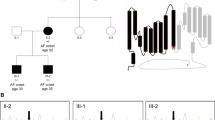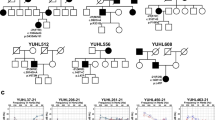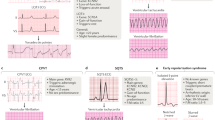Abstract
Genetic factors contribute to the risk of sudden death from cardiac arrhythmias. Here, positional cloning methods establish KVLQT1 as the chromosome 11-linked LQT1 gene responsible for the most common inherited cardiac arrhythmia. KVLQT1 is strongly expressed in the heart and encodes a protein with structural features of a voltage-gated potassium channel. KVLQT1 mutations are present in affected members of 16 arrhythmia families, including one intragenic deletion and ten different missense mutations. These data define KVLQT1 as a novel cardiac potassium channel gene and show that mutations in this gene cause susceptibility to ventricular tachyarrhythmias and sudden death.
This is a preview of subscription content, access via your institution
Access options
Subscribe to this journal
Receive 12 print issues and online access
$209.00 per year
only $17.42 per issue
Buy this article
- Purchase on Springer Link
- Instant access to full article PDF
Prices may be subject to local taxes which are calculated during checkout
Similar content being viewed by others
References
Kannel, W.B., Cupples, A. & D'Agostino, R.B. Sudden death risk in overt coronary heart diseases: the Framingham study. Am. Heart J. 113, 799–804 (1987).
Willich, S.N. et al. Circadian variation in the incidence of sudden cardiac death in the Framingham heart study population. Am. J. Cardiol. 60, 801–806 (1987).
Trial II Investigators Effect of the antiarrhythmic agent moricizine on survival after myocardial infarction. N. Engl. J. Med. 327, 227–233 (1992).
Jervell, A. & Lange-Nielsen, F. Congenital deaf mutism, functional heart disease with prolongation of the QT interval, and sudden death. Am. Heart J. 54, 59–78 (1957).
Romano, C. Congenital cardiac arrhythmias. Lancet 1, 658 (1965).
Ward, O.C. A new familial cardiac syndrome in children. J. Ir. Med. Assoc. 54, 103–106 (1964).
Schwartz, P.J., Periti, M. & Malliani, A. The long QT syndrome. Am. Heart J. 109, 378–390 (1975).
Moss, A.J. & McDonald, J. Unilateral cervicothoracic sympathetic ganglionectomy for the treatment of long QT interval syndrome. N. Engl. J. Med. 285, 903–904 (1970).
Zipes, D.P. Proarrhythmic effects of antiarrhythmic drugs. Am. J. Cardiol. 59, 26E–31E (1987).
Keating, M.T. et al. Linkage of a cardiac arrhythmia, the long QT syndrome, and the Harvey ras-1 gene. Science 252, 704–706 (1991).
Keating, M.T. et al. Consistent linkage of the long QT syndrome to the Harvey ras-1 locus on chromosome 11. Am. J. Hum. Genet. 49, 1335–1339 (1991).
Jiang, C. et al. Two long QT syndrome loci map to chromosomes 3 and 7 with evidence for further heterogeneity. Nature Genet. 8, 141–147 (1994).
Schott, J. et al. Mapping of a gene for long QT syndrome to chromosome 4q25–27. Am. J. Hum. Genet. 57, 1114–1122 (1995).
Curran, M.E. et al. A molecular basis for cardiac arrhythmia: HERG mutations cause long QT syndrome. Cell 80, 795–803.
Sanguinetti, M.C., Jiang, C., Curran, M.E. & Keating, M.T. A mechanistic link between an inherited and an acquired cardiac arrhythmia: HERG encodes the 1Kr potassium channel. Cell 81, 299–307 (1995).
Trudeau, M.C., Warmke, J., Ganetzky, B. & Robertson, G. HERG, a human inward rectifier in the voltage-gated potassium channel family. Science 269, 92–95 (1995).
Wang, Q. et al. SCN5A mutations associated with an inherited cardiac arrhythmia, long QT syndrome. Cell 80, 805–811 (1995).
Wang, Q. et al. Cardiac sodium channel mutations in patients with long QT syndrome, an inherited cardiac arrhythmia. Hum. Mol. Genet. 4, 1603–1607 (1995).
Wymore, R.S. et al. Genomic organization, nucleotide sequence, biophysical properties, and localization of the voltage-gated K+ channel gene KCN4A/Kv1.4 to mouse chromosome 2/human 11 p14 and mapping of KCNC1/Kv3.1 to mouse 7/human 11 p14.3–p15.2 and KCNA1/Kv1.1 to human 12p13. Genomics 20, 191–202 (1994).
Russell, M.W. et al. Localization of Romano-Ward long QT syndrome gene, LQT1, to the interval between tyrosine hydroxylase (TH) and D11S1349 . Am. J. Hum. Genet. 57, 503–507 (1995).
Gyapay, G. et al. The 1993–94 Genethon human genetic linkage map. Nature Genet. 7, 246–339 (1994).
Tanigami, A. et al. Mapping of 262 DNA markers into 24 intervals on human chromosome 11. Am. J. Hum. Genet. 50, 56–64 (1992).
Tokino, T. et al. Isolation and mapping of 62 new RFLP markers on human chromosome 11. Am. J. Hum. Genet. 48, 258–268 (1991).
Pongs, O. et al. Shaker encodes a family of putative potassium channel proteins in the nervous system of Drosophila. EMBO J. 7, 1087–1095 (1988).
Wang, Q. & Keating, M.T. Isolation of P1 insert ends by direct sequencing. BioTechniques 17, 282–284 (1994).
MacKinnon, R. Determination of the subunit stoichiometry of a voltage-activated potassium channel. Nature 350, 232–235 (1991).
MacKinnon, R., Aldrich, R.W. & Lee, A.W. Functional stoichiometry of shaker potassium channel inactivation. Science 262, 757–759 (1993).
Covarrubias, M., Wei, A. & Salkoff, L., shaker, shal, shab, and shaw express independent K+ current systems. Neuron 7, 763–773 (1991).
Schwartz, P. et al. Long QT syndrome patients with mutations of the SCN5A and HERG genes have differential responses to Na+ channel blockade and to increases in heart rate. Implications for gene-specific therapy. Circulation(in the press).
Anderson, M.A. & Gusella, U.K. Use of cyclosporin A in establishing Epstein-Barr virus-transformed human lymphoblastoid cell lines. In Vitro 20, 856–858 (1984).
Lathrop, G.M., Lalouel, J.-M., Julier, C. & Ott, J. Multilocus linkage analysis in humans: detection of linkage and estimation of recombination. Am. J. Hum. Genet. 37, 482–498 (1985).
Green, E.D. & Olson, M.V. Systematic screening of yeast artificial-chromosome libraries by use of the polymerase chain reaction. Proc. Natl. Acad. Sci. USA 87, 1213–1217 (1990).
Kwiatowski, T.J., Zoghbi, H.Y., Ledbetter, S.A., Ellison, K.A. & Chinault, A.C. Rapid identification of yeast artificial chromosome clones by matrix pooling and crude lysate PCR. Nucl. Acids Res. 17, 7191–7192 (1990).
Ochman, H., Gerber, A.S. & Hartl, D.L. Genetic application of an inverse polymerase chain reaction. Genetics 120, 621–623 (1988).
Sternberg, N. Bacteriophage P1 cloning system for the isolation, amplification, and recovery of DNA fragments as large as 100 kilobase pairs. Proc. Nati. Acad. Sci. USA 87, 103–107 (1990).
Sambrook, J., Fritsch, E.F. & Maniatis, T., Cloning: A Laboratory Manual. Second Edition. (Cold Spring Harbor Laboratory Press, New York, 1989).
Burn, T.C., Connors, T.D., Klinger, K.W. & Landes, G.M. Increased exon trapping efficiencies through modifications to the pSPLS splicing vector. Gene 161, 183–187 (1995).
Buckler, A.J. et al. Exon amplification: a strategy to isolate mammalian genes based on RNA splicing. Proc. Natl. Acad. Sci. USA 88, 4005–4009 (1991).
Church, D.M. et al. Isolation of genes from complex sources of mammalian genomic DNA using exon amplification. Nature Genet. 6, 98–104 (1994).
Marchuk, D., Drumm, M., Saulino, A. & Collins, F.S. Construction of T-vectors, a rapid and general system for direct cloning of unmodified PCR products. Nucl. Acids Res. 19, 1154 (1990).
Author information
Authors and Affiliations
Rights and permissions
About this article
Cite this article
Wang, Q., Curran, M., Splawski, I. et al. Positional cloning of a novel potassium channel gene: KVLQT1 mutations cause cardiac arrhythmias. Nat Genet 12, 17–23 (1996). https://doi.org/10.1038/ng0196-17
Received:
Accepted:
Issue Date:
DOI: https://doi.org/10.1038/ng0196-17
This article is cited by
-
A conditional mutation in a wheat (Triticum aestivum L.) gene regulating root morphology
Theoretical and Applied Genetics (2024)
-
Value of next-generation sequencing in inherited arrhythmia syndromes
International Journal of Arrhythmia (2023)
-
Ligand activation mechanisms of human KCNQ2 channel
Nature Communications (2023)
-
Activation of Kv7 channels normalizes hyperactivity of the VTA-NAcLat circuit and attenuates methamphetamine-induced conditioned place preference and sensitization in mice
Molecular Psychiatry (2023)
-
The Advantages, Challenges, and Future of Human-Induced Pluripotent Stem Cell Lines in Type 2 Long QT Syndrome
Journal of Cardiovascular Translational Research (2023)



